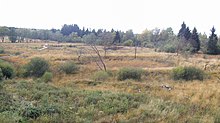Palsa
As Palsa (plural: Palsas also Palsen) are in areas with low oval elevations permafrost referred to in Mooren by a bottom located in the core consisting of eisreichem frozen peat and ice lenses , are formed. A palsa, like a pingo , consists of a frozen core and the (raised) soil material above it, in the case of a palsa mostly peatland.
genesis
A palsa needs large amounts of water to form its core (consisting of frozen peat and several ice lenses), which is why its formation is bound to peat soils, which can store enormous amounts of water in their pore space. In the places where the winter freezing front penetrates faster in a bog (due to a thinner snow cover compared to the surrounding area), ice accumulation is preferred to the surrounding bog soil. Ice lenses form, which grow at the expense of the surrounding water, whereby they exert pressure on the surrounding soil due to the volume expansion of the ice during freezing and thus press water out of the pores of the ground , which in turn can freeze onto the ice lenses and cause further volume expansion. A self-reinforcing mechanism develops. In the case of palsas, however, the pressing of water out of the pore space is not decisive, since the peat soil is water-saturated and therefore enough water is available for the ice core to grow.
As the volume of the freezing ice continues to expand, the overlying moor layer is gradually lifted up, the more the core grows. A palsa has emerged. The frozen core of a palsa shows a stratification that is caused by the different (winter) freezing intervals and the ice segregation .
Palsas arise mainly in bogs and are therefore also eponymous for a certain type of bog : the palsa bog .
There are also similar forms outside of moors, which are classified as palsas due to their size.
Palsas begin to decay when the protective peat cover tears up. The ice core is thawing and thermokarst lakes can arise.
Locations

Like pingos, palsas are typical forms of the permafrost area and are therefore common in northern America, in Siberia, in northern Scandinavia, on Greenland and Iceland , in the Antarctic as well as in Alaska and - rarely - on Svalbard.
Remnants of the Ice Age Palsen can also be found in raised bogs in Central Europe, for example in the High Fens in the German-Belgian border area.
Differences and similarities between pingos and palsas
Palsas are very similar to pingos in their morphology and formation , but with heights between about 1 and 10 meters and lengths between about 15 and 150 meters, they are significantly smaller than pingos. Furthermore, in contrast to pingos, palsas do not occur in isolation, but mostly in groups together with other palsas, for example in the palsamoor.
Both palsas and pingos are created by freezing water to an ice core. In the case of palsas, however, hydrostatic overpressure (for water injection) does not necessarily have to be present, since the bog soil is water-saturated and can store large amounts of water, so that sufficient water is initially available for the formation of the ice lens. For pingogenesis (especially for pingos of the closed system ), on the other hand, water injection due to hydrostatic overpressure, which is caused by the volume expansion of the ice as a result of freezing.
Web links
- Pingos and Palsen - in the learning portal for an introduction to physical geography, Department of Geosciences, Free University of Berlin
- Palse - entry in the lexicon of geography on Spektrum.de
Individual evidence
- ↑ a b c Jürgen Ehlers : The Ice Age . Spektrum Akademischer Verlag, 2011, ISBN 978-3-8274-2327-6 , 8.2.7.2 Palsas, p. 205-206 .
